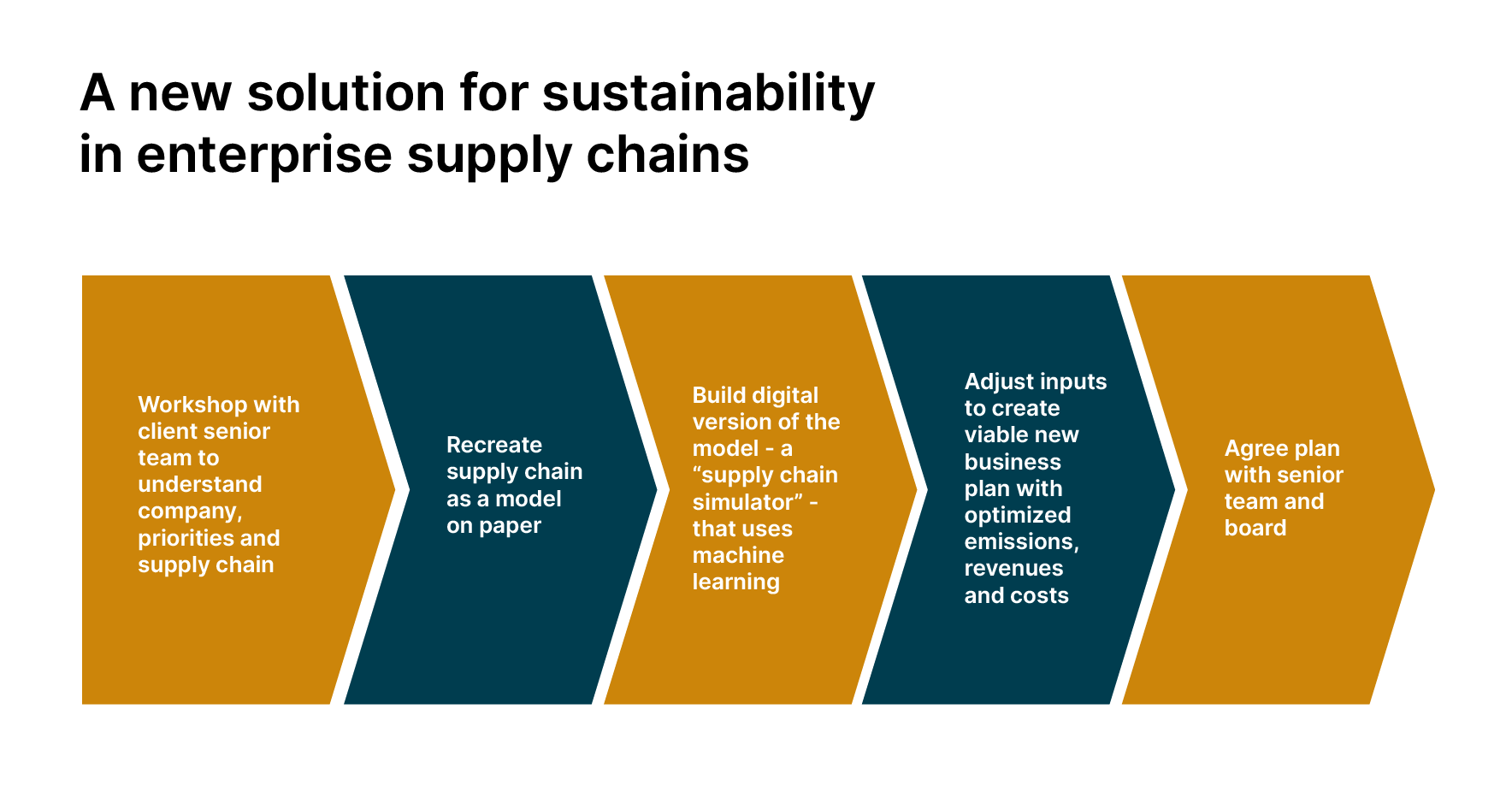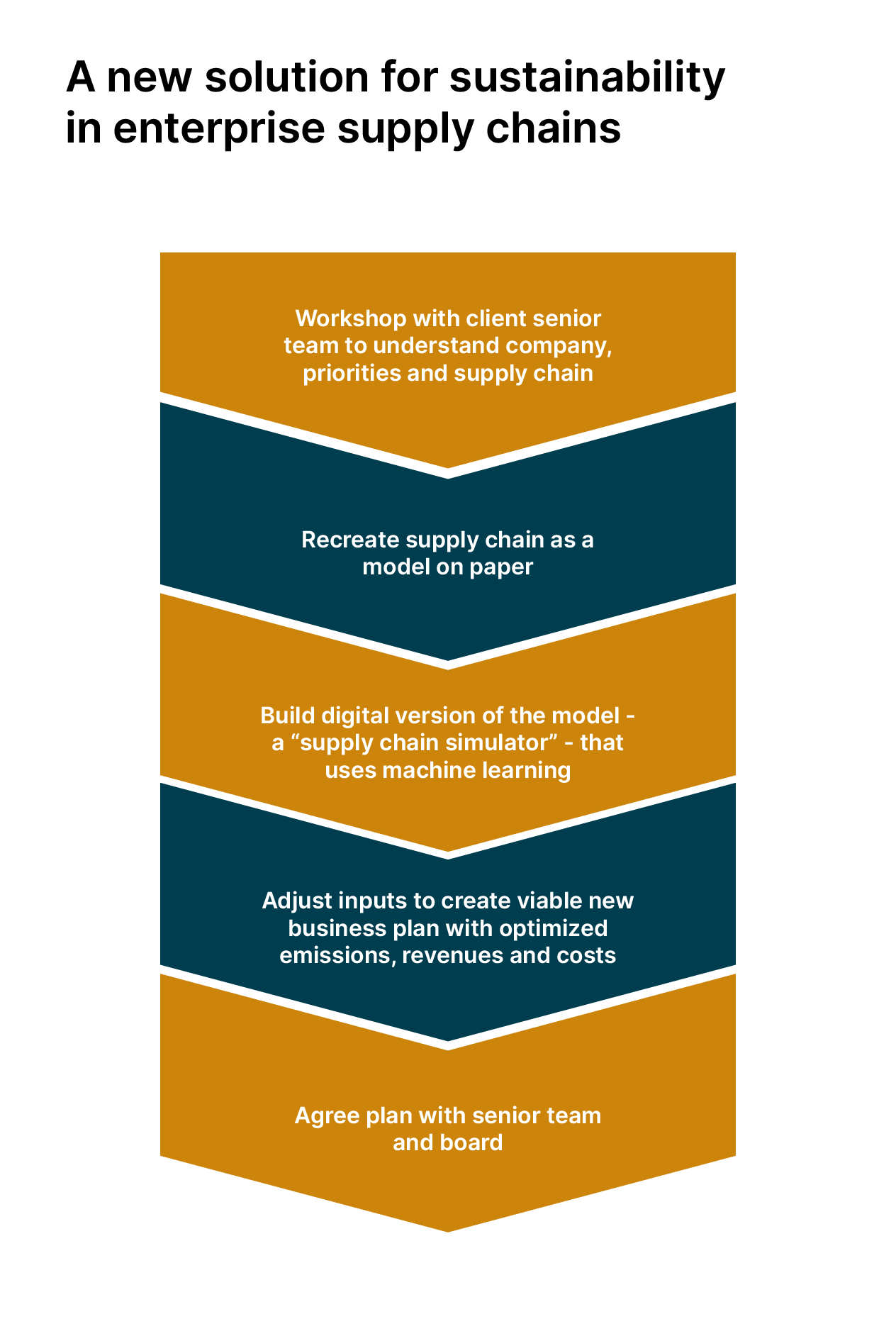Emissions and supply chains
Enterprises are under greater pressure than ever before to significantly reduce their carbon emissions and move to more sustainable business models. The demand for change is escalating rapidly — as the world saw at COP26 last month — and it comes from citizens, governments, investors, consumers, and companies themselves.
But how can enterprises decide on the right actions to take, and optimize their choices to reduce emissions and reduce costs? How can they integrate sustainability into their business models, instead of relying on offsetting alone? And how can they do this while remaining competitive?
Looking closely at a company’s supply chain is the way to get a meaningful picture of its emissions and it’s there that impactful actions can be found. But for most enterprises, supply chains are complex and come with a diverse geographic footprint. Make an adjustment here, and the impacts will be felt across the supply chain — and these impacts have varying consequences and cost implications.
Given the nature of supply chains, solutions are required that pinpoint exactly where emissions improvements can be made, while also showing the trade-offs. If you move to green energy and organic raw materials, what will that do for revenues and profits, as well as your environmental profile?
Can you still run a viable business if you remove carbon-intensive processes from your manufacturing, and make all deliveries by electric vehicles? How can you best work with partners in your supply chain to achieve environmental goals? How can you advise your clients to reduce their own emissions, by adjusting the ways they use your products and services?
Inaction around sustainability is often caused by an assumption: that making changes will negatively affect the bottom line. It doesn’t have to be that way.
Taking a decision science approach to sustainability in enterprise supply chains
The questions above are urgent ones for many of today’s businesses. Finding the answers means making a methodical examination of your supply chain from an emissions and costs perspective, and then, we believe, applying a decision science approach which uses machine learning.
We recently worked with an international manufacturing and services company to do just this, partnering to identify actionable insights, and model a range of future scenarios. This in turn allowed us to jointly develop an efficient roadmap towards the company’s target of providing carbon-neutral services by 2035, beyond what was possible using traditional decision-making methods. By working with us to create this roadmap, the company gained a significant return on its investment in the partnership.
It’s a solution which allows a company to make adjustments to its plan as its circumstances change - for instance if new technology, or new sources of finance, become available to it. It provides not only actionable insights to decision makers within an enterprise, but also transparency, helping to align investors, employees, customers, partners and other stakeholders with the company’s plan and priorities.
A particularly interesting aspect of our work together is that we created a bespoke simulator, which allows decision makers to change the assumptions and variables to show how a range of future scenarios would affect carbon dioxide emissions and costs. Machine learning was also used to suggest and optimize choices available to management, greatly helping their decision-making process.
A new solution for sustainability in enterprise supply chains
We believe our new solution can be applied across a range of industries in pursuit of a variety of sustainability goals. In the particular case above, we began by engaging the client’s senior team, to understand the business, its priorities and its stakeholders. We focused on the supply chain of one of its most significant service lines in one of its most significant markets.
Alongside numerical datasets, crucial knowledge about markets, processes, dependencies and other factors was held in the minds of the company’s leaders and subject matter experts. We crystallized this group’s knowledge and built relationships that ensured the project became a truly joint project.
We added to this growing stack of data and knowledge by talking to industry experts outside the company, and researching more widely on harmful emissions.
Using all this information, we jointly created a model on paper of how the business worked, reflecting interdependencies around carbon emissions and costs. The model laid out elements such as demand, choices around which raw materials are used, pricing and use of different types of trucks for transport, together with energy sources, water consumption and other factors.
We then re-created this model as a mathematical system using dynamical models and concepts, refining it in consultation with our client. The model allowed us to capture complex business processes in a way that a computer can understand. Having used the data to create a bespoke piece of software, we were able to deliver a custom supply chain sustainability simulator, developed for the enterprise.
The simulator uses a dashboard format to show predicted outcomes in terms of emissions and financial costs if relevant elements of the supply chain are changed. The inputs can be adjusted using simple sliders, and the outcomes can be seen in user-friendly charts that can easily be shared.


Creating a roadmap to greater sustainability for our client
Using the simulator, we generated a range of scenarios under which elements of the supply chain were changed, in a series of projects over a number of years. The simulator showed the effects in terms of carbon emissions and financial costs of undertaking these projects.
Importantly for our client, the whole solution, including the simulator, provided the management and the board with actionable insights on which they could make plans to modify the business. It showed how to tackle the root causes of harmful emissions generated by the enterprise, rather than just modeling how offsets could help.
The supply chain sustainability simulator can also be refined and input data continuously updated over time as the business develops, adjusts its supply chain and reacts to changes in its market.
To provide transparency, data, logic and algorithms governing the simulated scenarios can all be traced back to individual data sets within the company (which can be integrated), together with specific interviews and broader industry data.
We used machine learning to help identify and refine the best options available to the customer for lowering costs, increasing revenue and lowering emissions, in order to achieve zero carbon impact in stages before 2035.
Options for changing the business model included using greener energy and transport, replacing inefficient manufacturing steps, whether to use centralized service locations or be hyperlocal, different customer pricing strategies and whether to vary the set of manufacturing materials.
Once the options had been sufficiently refined, a viable plan was presented to the board. It is now being put into action and was recently announced publicly, further enhancing the company’s already strong reputation for taking action to protect the environment.
The potential for supply chain sustainability simulators
We believe the potential for supply chain sustainability simulators like this is significant — using, as they do, machine learning to help suggest the best routes to specific emissions and cost outcomes over defined time periods. We can also see them being used in pursuit of other goals, such as consolidating supply chains or managing dependencies.
The transparency of this approach is particularly useful as modifying supply chains can involve not just changes to processes, but also changes to culture. We think the modeling in our solution gives employees the opportunity to see how changes to their work can impact the larger sustainability goals of the business.
In mature companies in particular, this transparency could be very helpful for communicating with employees, as environmentally-driven process change could mean disruption to jobs and long-established ways of doing things.
For larger companies which have many small businesses in their supply chains, the modeling could be used to map impact on these businesses. Help could be offered to ensure these suppliers can align themselves to the larger company’s sustainability roadmap.
With the scale of climate change facing us today, it's important that technology is applied rapidly and judiciously to help enterprises and other organizations operate more sustainably. Company leaders are looking to identify efficient actions and take sometimes difficult decisions — we believe that our decision science approach to sustainability in enterprise supply chains can help.















